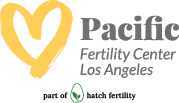Ovarian torsion
Although rare, ovarian torsion is a serious but treatable risk of in vitro fertilization (IVF). Contact us to talk with a fertility expert and determine an effective plan of action if you are experiencing symptoms of this complication.
|
Our doctors are equipped to diagnose and effectively treat ovarian torsion and are available from the Pacific Fertility Center’s Los Angeles location. |
What is ovarian torsion?
Ovarian torsion is a painful condition that is the result of an ovary becoming twisted around its supportive tissues. Women undergoing IVF who experience sudden and severe abdominal pain must seek medical attention right away. When properly treated, ovarian torsion does not have an impact on the ability to conceive
|
An ovarian torsion is considered a medical emergency that requires urgent care. |
|
Symptoms of ovarian torsion
Symptoms of ovarian torsion include:
- Sudden and severe pain in the lower abdomen
- Abdominal cramping
- Nausea or vomiting
In some cases, lower abdominal discomfort may be intermittent over a period of several weeks. This is due to the ovary trying to untwist into the correct position. Ovarian torsion should be treated quickly because prolonged blood loss can cause death of an ovary.
Causes of ovarian torsion
Ovarian torsion occurs when ovarian instability occurs. For example, masses on the ovary make the organ disproportionate and vulnerable to torsion. However, it’s important to understand that ovarian torsion is relatively rare. Studies have shown that it accounts for less than three percent of gynecologic complaints.
The risk factors for this condition include:
- Undergoing fertility treatment, such as IVF
- Having polycystic ovarian syndrome
- Having undergone tubal ligation
- Having a long ovarian ligament
- Being pregnant
If any of these risk factors apply to you, it pays to be aware of the symptoms of ovarian torsion and to take action quickly if you believe you are experiencing complications of any kind.
Determining a diagnosis
If you are experiencing symptoms of ovarian torsion, a preliminary diagnosis is achieved through a pelvic exam to assess pain and a transvaginal ultrasound to view your reproductive tract. Additional tests may be performed to rule out conditions that have symptoms similar to ovarian torsion, such as a urinary tract infection or appendicitis. These methods can help make a preliminary diagnosis, but a definitive diagnosis is often only possible during surgery.
Treatment options for ovarian torsion
Ovarian torsion is usually treated with laparoscopic surgery. During this minimally invasive procedure, a small incision is made at the abdomen. A laparoscope (an instrument with a small lighted camera at the end) is inserted. The laparoscope transmits images onto a screen, which guides the surgeon in addressing the torsion.
Patients are typically discharged the same day. With prompt treatment, ovarian torsion does not compromise the ability to conceive. If treatment is delayed and lack of blood flow has caused tissue death, your doctor will need to remove the ovary. An oophorectomy (ovary removal) is usually performed laparoscopically.
Tips to minimize IVF complications
Discover various fertility services that can minimize possible health risks posed by assisted reproductive technology.
Give your body downtime
Leverage frozen embryo transfers to preserve your fertility, give your body downtime between treatments, or after procedures and repeat IVF cycles if your first attempt is unsuccessful.
Consider natural IVF
Experience no risk of medication side effects and no waiting periods with natural IVF, a form of IVF that doesn’t use fertility medications and follows your natural cycle.
Receive proactive care and prevent risks
If you are experiencing symptoms of ovarian torsion, you should seek emergency medical care.
*Every patient’s IVF journey is unique and with different risk levels present. Consult with your doctor to understand the risks associated with your chosen fertility treatment.

Westwood Location
10880 Wilshire Blvd, Ste 300
Los Angeles, CA 90024
Call Us: (310) 564-9194
Glendale Location
1818 Verdugo Blvd, Ste 402
Glendale, CA 91208
Call Us: (310) 564-9194




